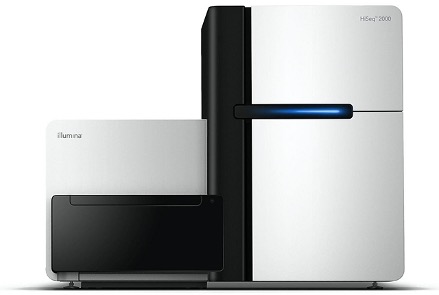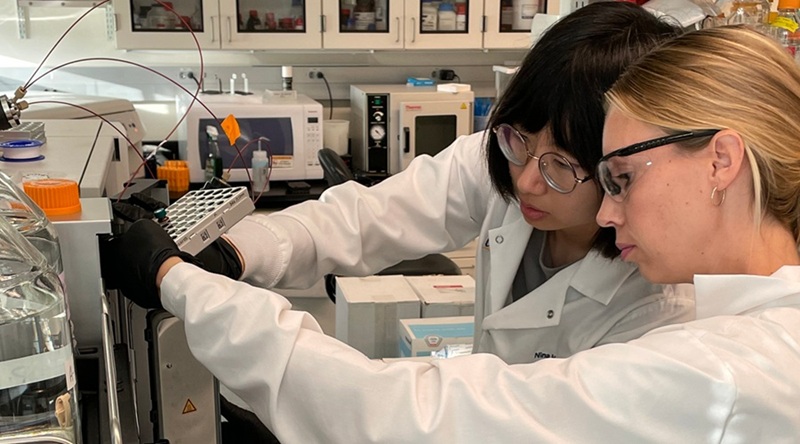Isoform-Specific Loss Of Dystonin Causes Charcot-Marie-Tooth Disease
|
By LabMedica International staff writers Posted on 20 Aug 2020 |

The HiSeq 2000 Sequencing System (Photo courtesy of Illumina).
Charcot-Marie-Tooth (CMT) disease, also called hereditary motor and sensory neuropathy, is among the most common neurogenetic diseases and is characterized by progressive length-dependent weakness and sensory loss.
CMT is divided into demyelinating (type 1) and axonal (type 2) forms of the disease based on clinical, electrophysiological, histological, and genetic features. Recessively inherited demyelinating neuropathies are called CMT4, whereas recessively inherited axonal neuropathies are called autosomal recessive (AR)-CMT.
Neurologists at the University of Pennsylvania School of Medicine (Philadelphia, PA, USA) and their colleagues applied whole exome sequencing (WES) to analyze the more than 30 million base pairs of DNA that encode the 20,000 proteins in humans. By examining three siblings, two affected and one unaffected, they were able to deduce the genetic basis of mutations that caused the two siblings to be affected.
Genomic DNA was isolated from peripheral blood from all participants. Exome DNA was captured using the SureSelect, Human All Exon5 50 Mb kit (Agilent Technologies, Santa Clara, CA, USA) and sequenced on a HiSeq 2000 (Illumina, San Diego, CA, USA). RNA was isolated from skin using the ZR-Duet DNA/RNA MiniPrep Plus kit (Zymo, Irvine, CA, USA). Complementary DNA (cDNA) was reverse transcribed using SuperScript III First-Strand Synthesis System (Invitrogen, Waltham, MA, USA).
The team identified compound heterozygous mutations in dystonin (DST), which is alternatively spliced to create many plakin family linker proteins (named the bullous pemphigoid antigen 1 [BPAG1] proteins) that function to bridge cytoskeletal filament networks. One mutation (c.250C>T) is predicted to cause a nonsense mutation (p.R84X) that only affects isoform 2 variants, which have an N-terminal transmembrane domain; the other (c.8283+1G>A) mutates a consensus splice donor site and results in a 22 amino acid in-frame deletion in the spectrin repeat domain of all BPAG1a and BPAG1b isoforms.
Steven S. Scherer, MD, PhD, a professor of Neurology and senior author of the study, said, “We are in the era where treatments for genetic diseases are possible. This brother and sister stand to benefit from that approach because we know the gene that is missing, and if we could replace it, that should at least prevent their progression.”
The authors concluded that their findings introduce a novel human phenotype, axonal Charcot-Marie-Tooth, of recessive DST mutations, and provide further evidence that BPAG1 plays an essential role in axonal health. The study was published on July 31, 2020 in the journal Neurology Genetics.
Related Links:
University of Pennsylvania School of Medicine
Agilent Technologies
Illumina
Zymo
Invitrogen - Thermo Fisher
CMT is divided into demyelinating (type 1) and axonal (type 2) forms of the disease based on clinical, electrophysiological, histological, and genetic features. Recessively inherited demyelinating neuropathies are called CMT4, whereas recessively inherited axonal neuropathies are called autosomal recessive (AR)-CMT.
Neurologists at the University of Pennsylvania School of Medicine (Philadelphia, PA, USA) and their colleagues applied whole exome sequencing (WES) to analyze the more than 30 million base pairs of DNA that encode the 20,000 proteins in humans. By examining three siblings, two affected and one unaffected, they were able to deduce the genetic basis of mutations that caused the two siblings to be affected.
Genomic DNA was isolated from peripheral blood from all participants. Exome DNA was captured using the SureSelect, Human All Exon5 50 Mb kit (Agilent Technologies, Santa Clara, CA, USA) and sequenced on a HiSeq 2000 (Illumina, San Diego, CA, USA). RNA was isolated from skin using the ZR-Duet DNA/RNA MiniPrep Plus kit (Zymo, Irvine, CA, USA). Complementary DNA (cDNA) was reverse transcribed using SuperScript III First-Strand Synthesis System (Invitrogen, Waltham, MA, USA).
The team identified compound heterozygous mutations in dystonin (DST), which is alternatively spliced to create many plakin family linker proteins (named the bullous pemphigoid antigen 1 [BPAG1] proteins) that function to bridge cytoskeletal filament networks. One mutation (c.250C>T) is predicted to cause a nonsense mutation (p.R84X) that only affects isoform 2 variants, which have an N-terminal transmembrane domain; the other (c.8283+1G>A) mutates a consensus splice donor site and results in a 22 amino acid in-frame deletion in the spectrin repeat domain of all BPAG1a and BPAG1b isoforms.
Steven S. Scherer, MD, PhD, a professor of Neurology and senior author of the study, said, “We are in the era where treatments for genetic diseases are possible. This brother and sister stand to benefit from that approach because we know the gene that is missing, and if we could replace it, that should at least prevent their progression.”
The authors concluded that their findings introduce a novel human phenotype, axonal Charcot-Marie-Tooth, of recessive DST mutations, and provide further evidence that BPAG1 plays an essential role in axonal health. The study was published on July 31, 2020 in the journal Neurology Genetics.
Related Links:
University of Pennsylvania School of Medicine
Agilent Technologies
Illumina
Zymo
Invitrogen - Thermo Fisher
Latest Molecular Diagnostics News
- New 15-Minute Hepatitis C Test Paves Way for Same-Day Treatment
- Ovarian Cancer Assay Outperforms Traditional Tests in Early Disease Detection
- Ultrasensitive Method Detects Low-Frequency Cancer Mutations
- Blood Test Enables Non-Invasive Endometriosis Detection
- New Blood Biomarkers Help Diagnose Pregnancy-Linked Liver Complication
- Simple Urine Test to Revolutionize Bladder Cancer Diagnosis and Treatment
- Blood Test to Enable Earlier and Simpler Detection of Liver Fibrosis
- Genetic Marker to Help Children with T-Cell Leukemia Avoid Unnecessary Chemotherapy
- Four-Gene Blood Test Rules Out Bacterial Lung Infection
- New PCR Test Improves Diagnostic Accuracy of Bacterial Vaginosis and Candida Vaginitis
- New Serum Marker-Editing Strategy to Improve Diagnosis of Neurological Diseases
- World’s First Genetic Type 1 Diabetes Risk Test Enables Early Detection
- Blood Test to Help Low-Risk Gastric Cancer Patients Avoid Unnecessary Surgery
- First-Of-Its-Kind Automated System Speeds Myeloma Diagnosis
- Blood Protein Profiles Predict Mortality Risk for Earlier Medical Intervention
- First Of Its Kind Blood Test Detects Gastric Cancer in Asymptomatic Patients
Channels
Clinical Chemistry
view channel
Online Tool Detects Drug Exposure Directly from Patient Samples
Doctors often rely on patient interviews and medical records to determine what medications a person has taken, but this information is frequently incomplete. People may forget drugs they used, take over-the-counter... Read more
Chemical Imaging Probe Could Track and Treat Prostate Cancer
Prostate cancer remains a leading cause of illness and death among men, with many patients eventually developing resistance to standard hormone-blocking therapies. These drugs often lose effectiveness... Read moreHematology
view channel
MRD Tests Could Predict Survival in Leukemia Patients
Acute myeloid leukemia is an aggressive blood cancer that disrupts normal blood cell production and often relapses even after intensive treatment. Clinicians currently lack early, reliable markers to predict... Read more
Platelet Activity Blood Test in Middle Age Could Identify Early Alzheimer’s Risk
Early detection of Alzheimer’s disease remains one of the biggest unmet needs in neurology, particularly because the biological changes underlying the disorder begin decades before memory symptoms appear.... Read more
Microvesicles Measurement Could Detect Vascular Injury in Sickle Cell Disease Patients
Assessing disease severity in sickle cell disease (SCD) remains challenging, especially when trying to predict hemolysis, vascular injury, and risk of complications such as vaso-occlusive crises.... Read more
ADLM’s New Coagulation Testing Guidance to Improve Care for Patients on Blood Thinners
Direct oral anticoagulants (DOACs) are one of the most common types of blood thinners. Patients take them to prevent a host of complications that could arise from blood clotting, including stroke, deep... Read moreImmunology
view channel
Routine Blood Test Can Predict Who Benefits Most from CAR T-Cell Therapy
CAR T-cell therapy has transformed treatment for patients with relapsed or treatment-resistant non-Hodgkin lymphoma, but many patients eventually relapse despite an initial response. Clinicians currently... Read more
New Test Distinguishes Vaccine-Induced False Positives from Active HIV Infection
Since HIV was identified in 1983, more than 91 million people have contracted the virus, and over 44 million have died from related causes. Today, nearly 40 million individuals worldwide live with HIV-1,... Read more
Gene Signature Test Predicts Response to Key Breast Cancer Treatment
DK4/6 inhibitors paired with hormone therapy have become a cornerstone treatment for advanced HR+/HER2– breast cancer, slowing tumor growth by blocking key proteins that drive cell division.... Read more
Chip Captures Cancer Cells from Blood to Help Select Right Breast Cancer Treatment
Ductal carcinoma in situ (DCIS) accounts for about a quarter of all breast cancer cases and generally carries a good prognosis. This non-invasive form of the disease may or may not become life-threatening.... Read moreMicrobiology
view channel
Blood-Based Diagnostic Method Could Identify Pediatric LRTIs
Lower-respiratory tract infections (LRTIs) are a leading cause of illness and death worldwide, and pneumonia is the leading infectious cause of death in children under five, claiming the lives of over... Read more
Rapid Diagnostic Test Matches Gold Standard for Sepsis Detection
Sepsis kills 11 million people worldwide every year and generates massive healthcare costs. In the USA and Europe alone, sepsis accounts for USD 100 billion in annual hospitalization expenses.... Read moreRapid POC Tuberculosis Test Provides Results Within 15 Minutes
Tuberculosis remains one of the world’s deadliest infectious diseases, and reducing new cases depends on identifying individuals with latent infection before it progresses. Current diagnostic tools often... Read more
Rapid Assay Identifies Bloodstream Infection Pathogens Directly from Patient Samples
Bloodstream infections in sepsis progress quickly and demand rapid, precise diagnosis. Current blood-culture methods often take one to five days to identify the pathogen, leaving clinicians to treat blindly... Read morePathology
view channel
Rapid Low-Cost Tests Can Prevent Child Deaths from Contaminated Medicinal Syrups
Medicinal syrups contaminated with toxic chemicals have caused the deaths of hundreds of children worldwide, exposing a critical gap in how these products are tested before reaching patients.... Read more
Tumor Signals in Saliva and Blood Enable Non-Invasive Monitoring of Head and Neck Cancer
Head and neck cancers are among the most aggressive malignancies worldwide, with nearly 900,000 new cases diagnosed each year. Monitoring these cancers for recurrence or relapse typically relies on tissue... Read more
Common Health Issues Can Influence New Blood Tests for Alzheimer’s Disease
Blood-based tests for Alzheimer’s disease are transforming diagnosis by offering a simpler alternative to spinal taps and brain imaging. However, many people evaluated at memory clinics also live with... Read more
Blood Test Formula Identifies Chronic Liver Disease Patients with Higher Cancer Risk
Chronic liver disease affects millions worldwide and can progress silently to hepatocellular carcinoma (HCC), one of the deadliest cancers globally. While surveillance guidelines exist for patients with... Read moreTechnology
view channel
Machine Learning Models Diagnose ALS Earlier Through Blood Biomarkers
Amyotrophic lateral sclerosis (ALS) is a rapidly progressive neurodegenerative disease that is notoriously difficult to diagnose in its early stages. Early symptoms often overlap with other neurological... Read more
Artificial Intelligence Model Could Accelerate Rare Disease Diagnosis
Identifying which genetic variants actually cause disease remains one of the biggest challenges in genomic medicine. Each person carries tens of thousands of DNA changes, yet only a few meaningfully alter... Read moreIndustry
view channel
Abbott Acquires Cancer-Screening Company Exact Sciences
Abbott (Abbott Park, IL, USA) has entered into a definitive agreement to acquire Exact Sciences (Madison, WI, USA), enabling it to enter and lead in fast-growing cancer diagnostics segments.... Read more




 assay.jpg)












